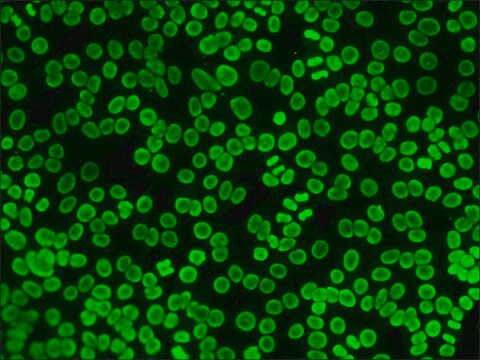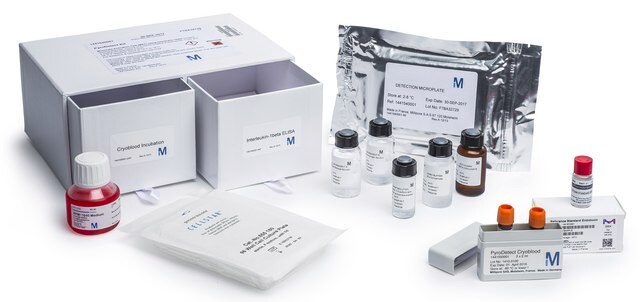F4890
Monoclonal Anti-Rabbit Immunoglobulins–FITC antibody produced in mouse
clone RG-16, purified immunoglobulin, buffered aqueous solution
Sinônimo(s):
Monoclonal Anti-Rabbit Immunoglobulins (IgG, IgA, IgM)
About This Item
Produtos recomendados
fonte biológica
mouse
conjugado
FITC conjugate
forma do anticorpo
purified immunoglobulin
tipo de produto de anticorpo
secondary antibodies
clone
RG-16, monoclonal
forma
buffered aqueous solution
não deve reagir com
pig, chicken, bovine, horse, human, guinea pig, turkey, rat, canine, goat, feline, sheep
condição de armazenamento
protect from light
técnica(s)
immunohistochemistry (formalin-fixed, paraffin-embedded sections): 1:20
indirect immunofluorescence: 1:50 using using chicken fibroblast cells and primary antibody produced in rabbit
Isotipo
IgG1
Condições de expedição
dry ice
temperatura de armazenamento
−20°C
modificação pós-traducional do alvo
unmodified
Procurando produtos similares? Visita Guia de comparação de produtos
Descrição geral
Especificidade
Aplicação
- immunocytochemistry
- immunohistochemistry
- immunofluorescence
forma física
Exoneração de responsabilidade
Não está encontrando o produto certo?
Experimente o nosso Ferramenta de seleção de produtos.
Código de classe de armazenamento
10 - Combustible liquids
Classe de risco de água (WGK)
nwg
Ponto de fulgor (°F)
Not applicable
Ponto de fulgor (°C)
Not applicable
Equipamento de proteção individual
Eyeshields, Gloves, multi-purpose combination respirator cartridge (US)
Certificados de análise (COA)
Busque Certificados de análise (COA) digitando o Número do Lote do produto. Os números de lote e remessa podem ser encontrados no rótulo de um produto após a palavra “Lot” ou “Batch”.
Já possui este produto?
Encontre a documentação dos produtos que você adquiriu recentemente na biblioteca de documentos.
Nossa equipe de cientistas tem experiência em todas as áreas de pesquisa, incluindo Life Sciences, ciência de materiais, síntese química, cromatografia, química analítica e muitas outras.
Entre em contato com a assistência técnica







